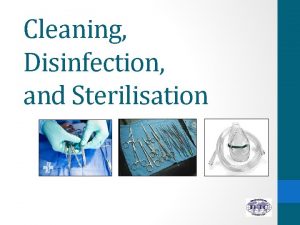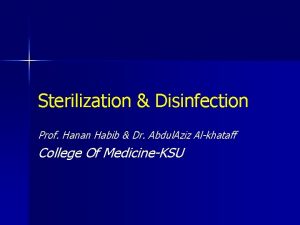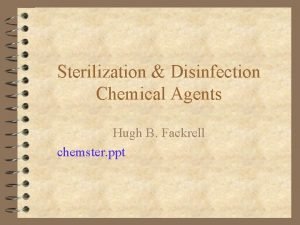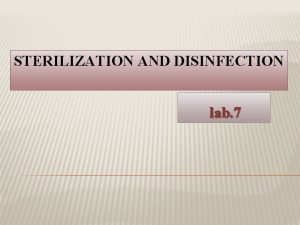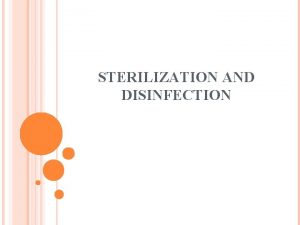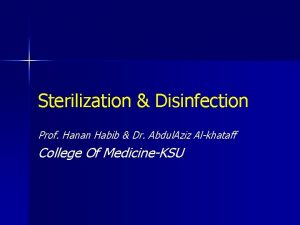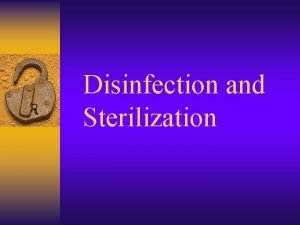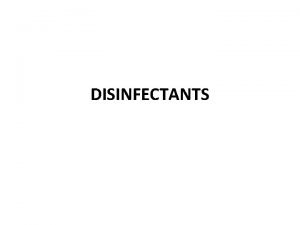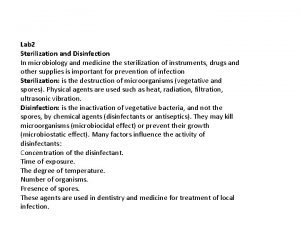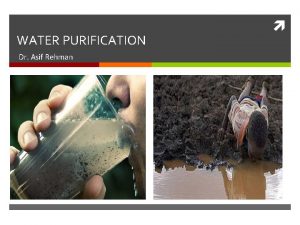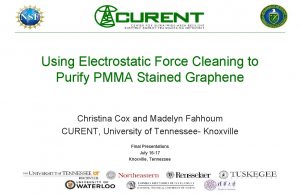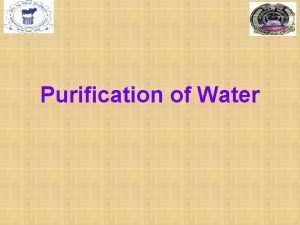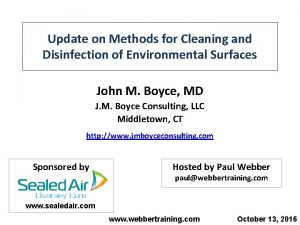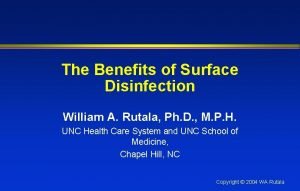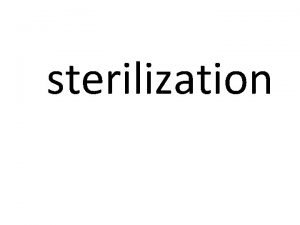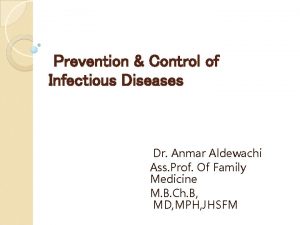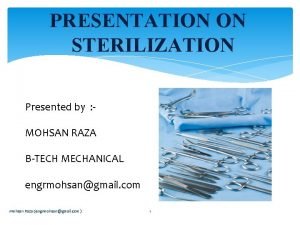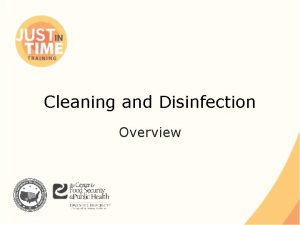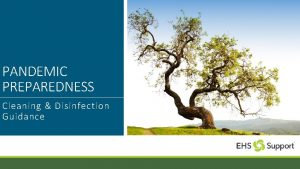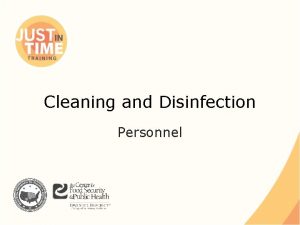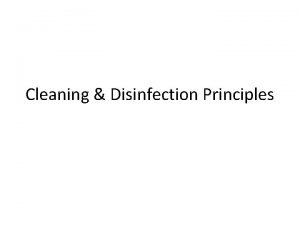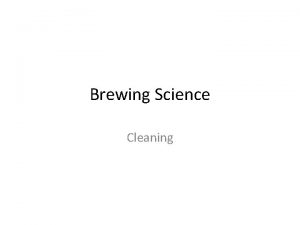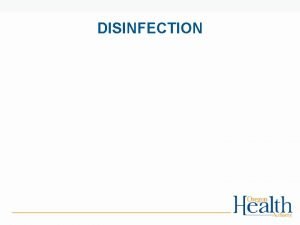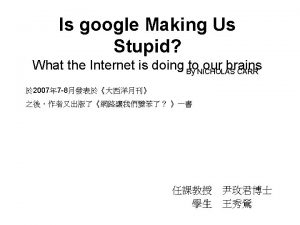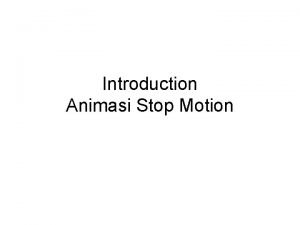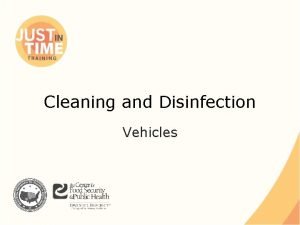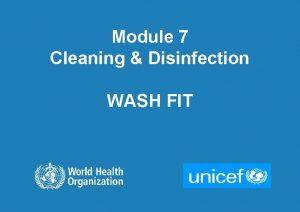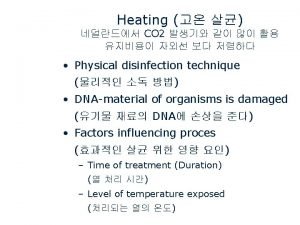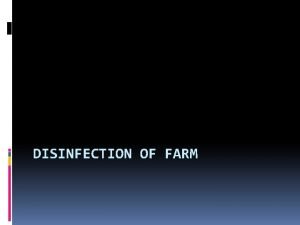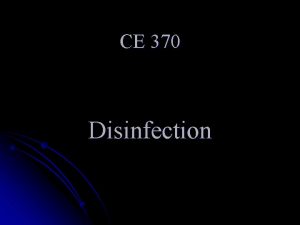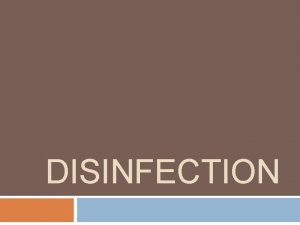Cleaning and Disinfection Overview Cleaning Disinfection CD Stop






















- Slides: 22

Cleaning and Disinfection Overview

Cleaning & Disinfection (C&D) ● Stop the spread of pathogens – Inactivate or destroy microorganisms ● Vital for animal health emergency situations ● Premises, equipment, vehicles, personnel ● Personnel must be knowledgeable – C&D methods, procedures, limitations – Safety issues Just In Time Training Cleaning and Disinfection: Overview

C&D Methods ● Reduce, remove, inactivate, destroy ● Methods vary in level of destruction ● Physical – Heat, UV light ● Chemical – Sanitizers – Disinfectants – Sterilants Just In Time Training Cleaning and Disinfection: Overview

Disinfectant Regulation ● Registered and regulated by EPA – Federal Insecticide, Fungicide and Rodenticide Act (FIFRA) – “Antimicrobial pesticides” ● Use in manner inconsistent with label – Ineffective application – “Misuse” of product Just In Time Training Cleaning and Disinfection: Overview

Efficacy Considerations ● Microorganism Considerations – Vary in susceptibility ● Environmental Considerations – Organic load – Water hardness – Temperature – Surface type – Other chemicals Just In Time Training Cleaning and Disinfection: Overview

Basic C&D Protocol ● Cleaning – Dry Cleaning – Washing – Rinse and dry ● Disinfection – Application – Contact Time – Rinse and dry ● Downtime Just In Time Training Cleaning and Disinfection: Overview

Cleaning ● Importance – Can remove 90% of microorganisms – Improves disinfection efficacy – Prior to application of disinfectant ● Three steps – Dry clean – Wash – Rinse and Dry Just In Time Training Cleaning and Disinfection: Overview

Cleaning: Dry Cleaning ● Removal of gross contamination – Organic material § Soil, manure, bedding, feed ● Moisten to control dust ● Air blowers should not be used – Risk of pathogen spread ● Disposal should minimize spread – Burning, burial, composting Just In Time Training Cleaning and Disinfection: Overview

Cleaning: Washing ● Most overlooked step ● Detergent – Reduces microorganisms – Removes oil, grease, exudates ● Shut off, remove or cover electrical equipment – Covered tightly with plastic – Electrician may be helpful ● May need pre-soaked Just In Time Training Cleaning and Disinfection: Overview

Cleaning: Washing ● High pressure water is very effective – Avoid if highly infectious or zoonotic ● Warm to hot water should be used ● Scrubbing may be necessary ● Steam – Effective for cracks, crevices, pipework Just In Time Training Cleaning and Disinfection: Overview

Rinse/Dry ● Rinse with cold water at low pressure ● Surfaces should be inspected – No beading should occur ● Surfaces should allow to dry completely – Overnight if possible ● Fans can be helpful in drying ● Do not use with zoonotic pathogens Just In Time Training Cleaning and Disinfection: Overview

Disinfection ● Application – Physical § Heat, UV light – Chemical § Disinfectant ● Contact time – Most important – May need reapplication ● Rinse after contact time Just In Time Training Cleaning and Disinfection: Overview

Downtime ● Free of any animals or activity ● Reduces pathogens by drying ● Time varies based on pathogen – Three times expected incubation period ● Block of area Just In Time Training Cleaning and Disinfection: Overview

Assessment and Planning ● Identify pathogen ● Determine areas & items ● Select proper disinfection method ● Identify & address hazards & safety issues ● Determine personnel, equipment & supplies needed Just In Time Training Cleaning and Disinfection: Overview

Site Selection ● Adjacent to entrance points ● Two scales – Small scale for personnel/small equipment – Large scale for vehicles, machinery ● House C&D components – Disinfection station – Water supply/waste water containment Just In Time Training Cleaning and Disinfection: Overview

Biosecurity Work Zones Just In Time Training Cleaning and Disinfection: Overview

Disinfectant Preparation ● Only EPA-registered products ● Fresh solutions only – Old solutions may have reduced efficacy ● Test kits – Determine chemical degradation of active ingredients Just In Time Training Cleaning and Disinfection: Overview

Evaluation ● Areas properly cleaned/disinfected ● Personnel aware of/implementing C&D measures ● Proper disinfectant selected – Appropriate concentration – Correct contact time achieved ● C&D Waste – Minimize or avoid environmental impact Just In Time Training Cleaning and Disinfection: Overview

Safety ● Chemical Hazards – Skin, eye, respiratory irritation – Ingestion (animals) ● Physical Hazards – Slips, trips, falls – Heat injury – High pressure sprayer ● Personal Protective Equipment (PPE) – Gloves, masks, eyes Just In Time Training Cleaning and Disinfection: Overview

ICS: C&D Group ● Part of Operations Section of ICS – Establish C&D protocols – Set up disinfection stations § Vehicles § Equipment § Personnel Just In Time Training Cleaning and Disinfection: Overview

C&D Team ● C&D Group Supervisor – C&D implemented effectively – Personnel know proper procedures – Identifies team members with required expertise ● C&D Team Leaders – Supervises on site activities ● C&D Team Members – Implement C&D procedures Just In Time Training Cleaning and Disinfection: Overview

Acknowledgments Development of this presentation was by the Center for Food Security and Public Health at Iowa State University through funding from the Multi-State Partnership for Security in Agriculture Authors: Glenda Dvorak, DVM, MPH, DACVPM; Ashley Osborn
 Data cleaning problems and current approaches
Data cleaning problems and current approaches Data quality and data cleaning an overview
Data quality and data cleaning an overview Data quality and data cleaning an overview
Data quality and data cleaning an overview De lin institute of technology
De lin institute of technology One stop teacher stop
One stop teacher stop Low level disinfectant
Low level disinfectant Sterilization and disinfection
Sterilization and disinfection Sterilization and disinfection
Sterilization and disinfection Sterilization and disinfection
Sterilization and disinfection Types of sterilization techniques
Types of sterilization techniques Role of nurse in sterilization and disinfection
Role of nurse in sterilization and disinfection Sterilization and disinfection
Sterilization and disinfection Low level disinfectant
Low level disinfectant Disinfection definition
Disinfection definition Sterilization and disinfection in microbiology lab
Sterilization and disinfection in microbiology lab Double pot method of water purification
Double pot method of water purification Electrostatic disinfection chelsea
Electrostatic disinfection chelsea Double pot method of chlorination
Double pot method of chlorination Dry mist disinfection machine
Dry mist disinfection machine Disinfection definition
Disinfection definition Disinfection type
Disinfection type Terminal disinfection ppt
Terminal disinfection ppt Sterilization by mechanical methods
Sterilization by mechanical methods





